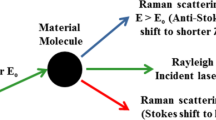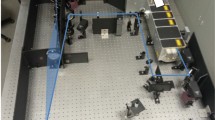Abstract
The detection and identification of explosive materials is required to defend the military forces and civilians. In this study we propose an integrated optoelectronics system composed of Raman Spectroscopy System and visible/near infrared hyperspectral camera for standoff real time in situ detection and identification of explosive traces on different background materials. Both systems are combined to overcome the limitations when using each system separately. For the preliminary investigation of the system efficiency, the detection of the most common explosive material, the trinitrotoluene (TNT), is tested. The proposed HSI system is tested for explosive detection at distance range from 1 to 30 m. The HSI successfully achieved detection of the traces of TNT at 30 m distance and detection limit of 1 µg/cm2. On the other hand, the Raman system could successfully detect a sample of 20 µg/cm2 of TNT at 1 m. Limitations of both systems are discussed. The obtained results show the ability of the recommended integrated system to overcome the limitations of each system separately and hence to accurately detect and identify the explosive materials.














Similar content being viewed by others
References
Bakeev, K.A., Chimenti, R.V.: Pros and cons of using correlation versus multivariate algorithms for material identification via handheld spectroscopy. Eur. Pharm. Rev. vol. Material Identificaction (2013)
Brown, K.E., et al.: Advances in explosives analysis—part II: photon and neutron methods. Anal. Bioanal Chem. 408, 49–65 (2016)
Buck, J.R., Daniel, M.M., Singer, A.C.: Computer Explorations in Signals and Systems Using MATLAB, 2nd edn. Prentice Hall, Upper Saddle River (2002)
Chaudhary, S., Ninsawat, S., Nakamura, T.: Non-destructive trace detection of explosives using pushbroom scanning hyperspectral imaging system. Sensors 19, 251 (2019)
Chaudhary, S., Ninsawat, S., Nakamura, T.: Non-destructive trace detection of explosives using pushbroom scanning hyperspectral imaging system. Sensors (switzerland) 19, 1–15 (2019)
Chung, J.H., Cho, S.G.: Nanosecond gated raman spectroscopy for standoff detection of hazardous materials. Bull. Korean Chem. Soc. 35(12), 3547–3552 (2014). https://doi.org/10.5012/bkcs.2014.35.12.3547
Dubroca, T., Brown, G., Hummel, R.E.: Detection of explosives by differential hyperspectral imaging. Opt. Eng. 53, 021112 (2014)
Edelman, G.J., Gaston, E., van Leeuwen, T.G., Cullen, P.J., Aalders, M.C.G., Pettersson, A.: Hyperspectral imaging for non-contact analysis of forensic traces. Forensic Sci. Int. 223, 28–39 (2012)
Fountain, A.W., et al.: Recent advances and remaining challenges for the spectroscopic detection of explosive threats. Appl. Spectrosc. 68, 795–811 (2014)
Fu, Y., Liu, H., Xie, J.: 100-m standoff detection of a QCL-induced photo-vibrational signal on explosives using a laser vibrometer. Opt. Lasers Eng. 107, 241–246 (2018)
Gaft, M., Nagli, L.: UV gated Raman spectroscopy for standoff detection of explosives. Opt. Mater. 30, 1739–1746 (2008)
Gares, K.L., et al.: Review of explosive detection methodologies and the emergence of standoff deep UV resonance Raman. J. Raman Spectrosc. 47, 124–141 (2016)
Gomer, S.T.N.R., Gardner, C. W., Nelson, M.P.: Real-time, wide-area hyperspectral imaging sensors for standoff detection of explosives and chemical warfare agents, presented at the Chem. Biol. Radiol. Nucl. Explos. Sens. XVIII (2017)
Gulati, K.K., Gulia, S., Gambhir, T., Kumar, N., Gambhir, V., Reddy, M.N.: Standoff detection and identification of explosives and hazardous chemicals in simulated real field scenario using time gated Raman spectroscopy. Def. Sci. J. 69, 342–347 (2019)
Hummel, R.E., Fuller, A.M., Schöllhorn, C., Holloway, P.H.: Detection of explosive materials by differential reflection spectroscopy. Appl. Phys. Lett. 88, 231903 (2006). https://doi.org/10.1063/1.2210077
Kögler, M., Heilala, B.: Time-gated Raman spectroscopy—a review. Meas. Sci. Technol. 32, 6004110 (2020)
Laserna, J.: Modern Techniques in Raman Spectroscopy. Wiley, New York (1996)
Lopez-Lopez, M., García-Ruiz, C.: Infrared and Raman spectroscopy techniques applied to identification of explosives. TrAC Trends Anal. Chem. 54, 36–44 (2014)
Marcus, L.S., Holthoff, E.L., Pellegrino, P.M.: Standoff photoacoustic spectroscopy of explosives. Appl. Spectrosc. 71, 833–838 (2017)
Misra, A.K., Sharma, S.K., Bates, D.E., Acosta, T.E.: Compact standoff Raman system for detection of homemade explosives. Proc. SPIE 7665, 1–11 (2010)
Mogilevsky, G., Borland, L., Brickhouse, M., Fountain, A.W.: Raman spectroscopy for homeland security applications. Int. J. Spectrosc. 2012, 754 (2012)
Park, J.-K., Park, A., Yang, S.K., Baek, S.-J., Hwang, J., Choo, J., Christodoulou, C.G.: Raman spectrum identification based on the correlation score using the weighted segmental hit quality index. Analyst 142, 380–388 (2017)
Smith, E., Dent, G.: Modern Raman Spectroscopy—A Practical Approach. Wiley, New York (2005)
Wallin, S., et al.: Laser-based standoff detection of explosives: a critical review. Anal. Bioanal. Chem. 395, 259–274 (2009)
Witinski, M.F., et al.: Portable standoff spectrometer for hazard identification using integrated quantum cascade laser arrays from 6.5 to 11 µm. Opt. Soc. Am. 26, 12159–12168 (2018)
Author information
Authors and Affiliations
Corresponding author
Additional information
Publisher's Note
Springer Nature remains neutral with regard to jurisdictional claims in published maps and institutional affiliations.
Rights and permissions
About this article
Cite this article
Abdallah, A., Mokhtar, A., Ayoub, H.S. et al. Experimental study on standoff detection of explosives traces using Laser Raman spectroscopy: challenges and possible solution. Opt Quant Electron 54, 345 (2022). https://doi.org/10.1007/s11082-022-03719-3
Received:
Accepted:
Published:
DOI: https://doi.org/10.1007/s11082-022-03719-3




